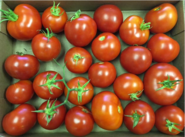 Seminole Nation in Choctaw, Oklahoma, Uses Aquaponics to Grow Food and Conserve Natural Resources - 1 year update!
In
2015, the Seminole Nation Food and Nutrition Program
installed an educational aquaponics system at its facility
and began growing plants and fish. During the first year of the project, the
tribe was able to provide starter plants to Food Distribution Program
on Indian Reservations (FDPIR) participants in
the spring and early summer. While planting seeds is the most common
way to propagate new plants, the program also used cuttings to
clone plants from the mother vines that had been growing since last summer.
These new plants provide households with fresh tomatoes for their meals.
|
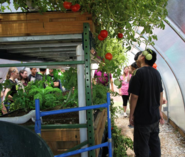 Using aquaponics to attract attention, the Seminole Nation has used this opportunity to teach individuals about nutrition and growing food, and to provide tours of its grocery center to teach people about the FDPIR program.
Recently, the Seminole Nation purchased 300 acres of land across from the local state college and children’s museum. The vision is to turn this site into a location that will provide education and technical assistance to anyone interested in learning about nutrition and agriculture, a vision that was sparked by a greenhouse with aquaponics.
|
Do you know where your food comes from? If you can pinpoint where your food was grown and produced, you can make more informed decisions to maximize quality, freshness, and nutritional value. You can also help support local economies through your purchases. The USDA Foods program takes this mantra to heart and publishes annual state of origin reports with procurement information for all USDA Foods purchases. As we like to say at FNS, “All USDA Foods are local to someone.”
USDA Foods are 100 percent American grown and produced. Each year, USDA procures more than 300 different food products, including meat, poultry, fish, fruits, vegetables, flour, cereals, and dairy products, totaling approximately $2 billion. Organizations such as food banks, disaster and emergency feeding organizations, Indian Tribal Organizations, schools, and other feeding programs receive these USDA Foods for use in meal service or distribution to households through programs like the National School Lunch Program, The Emergency Food Assistance Program, the Commodity Supplemental Food Program, and the Food Distribution Program on Indian Reservations.
Read more on the USDA Blog
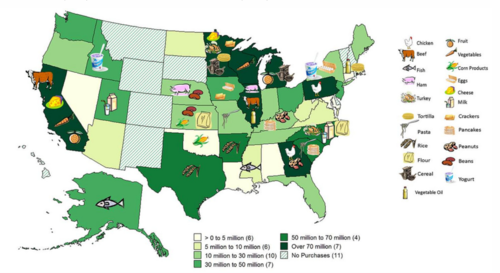 Map of the dollar value of USDA Foods purchased in FY 2014; icons represent the states that are the largest sources of a particular type of USDA Foods.

Over the
past five years, tuna has not been offered on the
Foods Available List, and now it may seem like a “new” USDA Food, but it's not.
USDA began purchasing domestic canned tuna for the National School Lunch
Program (NSLP) in 1985 based on availability
and market conditions. Starting in 2000, domestic supplies of tuna
were steadily available, fished from and processed on U.S. flagged ships and
canned in plants located in the continental U.S. However, competition from
foreign suppliers soon challenged the industry and companies that supplied tuna closed
their U.S. canneries. In 2011 USDA suspended tuna procurement
due to a lack of domestic suppliers.
Fortunately, companies have recently been able to open plants in
American Samoa, making tuna an option for USDA Foods again. The USDA began
purchasing tuna again for
NSLP and The Emergency Food Assistance Program (TEFAP) in March 2016 and the
response from recipients has been positive. Tuna is expected to be available
for CSFP and FDPIR to order this summer.
All deliveries thus
far have been received on time all the way from American Samoa!
|
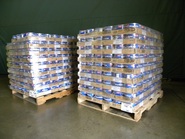 The first State to receive its deliveries of canned tuna was California. Sixteen other States have received canned tuna orders, totaling 1.3 million pounds for schools and .8 million pounds for TEFAP. So far, USDA has purchased a total of 2.1 million pounds and $3.6 M. USDA anticipates that supplies will be available for future orders and we can look forward to smooth sailing for American-produced tuna!
Canned tuna is shelf stable and can be kept in dry storage. View the tuna product information sheet for schools.
Tuna Trivia
Q. When was tuna first canned?
A. Tuna was first canned in 1903.
Q. Where was tuna first canned in the United States?
A. In California on Terminal Island from a thriving tuna fleet with a home port in San Diego.
|
USDA is delighted to announce the relaunch of the FDPIR Sharing Gallery, a resource for nutrition education, recipes and cookbooks, grant opportunities, photos and videos, news and newsletters, and presentations and training. We invite you to visit this new, collaborative website for ideas to incorporate into your local FDPIR program, and you may also contribute content to be posted to the Sharing Gallery by sending an email to USDAFoods@fns.usda.gov.
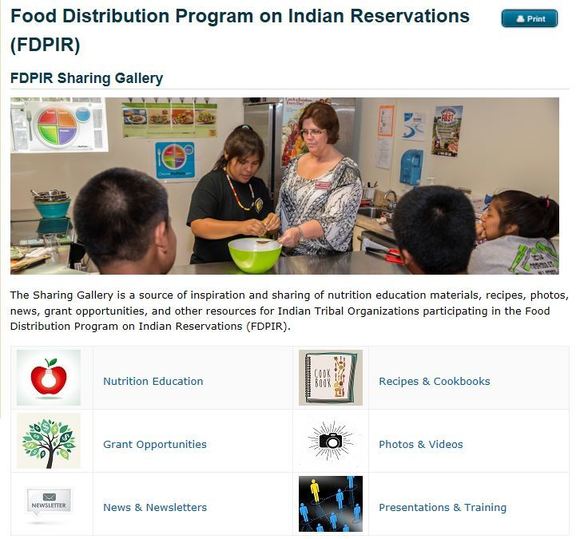
 American Commodity Distribution Association (ACDA) Annual
National Conference
On May 9-11, USDA, State and local agencies, industry, and partners gathered for the ACDA Annual National
Conference in St. Pete Beach, Florida. The conference focused on key areas such as USDA Foods processing, entitlement management, inventory management, warehousing, procurement, and other program, regulatory, and legislative updates. Staff provided content on a variety of programs, such as NSLP, TEFAP, CSFP, and CACFP (Child and Adult Care Food Program). Click here to learn more about ACDA.
|
School Nutrition Association (SNA) Annual National Conference
USDA Food and Nutrition Service and Agricultural Marketing
Service staff exhibited on USDA Foods during SNA’s Annual National Conference
in San Antonio, TX, July 11-13, 2016. We dialogued with a variety of
stakeholders on USDA Foods throughout the conference, in pre-conference
workshops, education sessions, and the exhibit hall. Many State and school
district representatives stopped by to provide feedback on USDA Foods
experience and share input on their USDA Foods priorities for the future. We welcome
feedback anytime at USDAFoods@fns.usda.gov.

In May and July, Food Distribution staff participated with other USDA staff in two volunteer events at DC Central Kitchen (DCCK). USDA volunteers assisted DCCK staff with preparing 5,000 balanced meals for schools, homeless shelters, transitional homes, and nonprofit organizations. Volunteers assisted with chopping, peeling, washing, and packaging food for distribution. This meaningful and educational volunteer opportunity gave USDA staff a deeper understanding of how their work helps to impact those in need.
USDA staff assist DC Central Kitchen with meal preparation for its food distribution program.
Ingredients:
2 seconds cooking oil spray
1 8-in” Whole Grain Tortilla
2 tbsp Mild Salsa
½ C Frozen Corn
2 ½ Oz Diced Chicken
½ Oz Shredded Yellow Cheddar Cheese
½ tsp Dried Chives
Directions:
Preheat oven to 400*F.
Cook corn according to package instructions.
Spray cookie sheet with cooking oil. Place tortilla on oiled sheet. Top with chicken, cooked corn, cheese, chives, and salsa. Bake for 10 minutes.
Cut in quarters and serve.
NUTRITION INFORMATION: Based on 1 individual pizza
Calories: 348 kcal
Total Fat: 11.91 g
Saturated Fat: 4.80 g
Trans Fat: 0
Cholesterol: 68.15 mg
Sodium: 409.5 mg
Carbohydrates: 40.35 g
This year, the Food Distribution Division, Program Integrity and Monitoring
Branch (PIMB), USDA Foods Complaints Team set high goals to ensure that we met
the expectations of our customers. Our goals included providing responsive
customer service, investigating and resolving complaint “root causes,” and providing
guidance and training on how to handle and store USDA Foods. We also work with our partners at the
Agricultural Marketing Service (AMS) to improve product specifications to
ensure consistent, high quality USDA Foods that meet customer expectations. PIMB
sees customer feedback and complaints as opportunities to make improvements and
help avoid adverse situations.
In November 2015, there were 660 open complaints,
but as of July 2016 there are only 19 open complaints waiting to be resolved. This success was achieved with team effort, collaboration, and
effective communication between FNS and AMS, and with our customers and
vendors.
One example of successful
resolution of a complaint involved a non-natural foreign object found in a 30
pound case of USDA Foods frozen unseasoned chicken strips. Upon opening a case
a school food service employee found a foreign object in the product. The employee took clear photos of the foreign
object and provided a detailed description of the issue along with the photos
to their State Distributing Agency (SDA).
The SDA entered the complaint into the Web-Based Supply Chain Management
(WBSCM) system along with additional required information, such as the Sales
Order Number, and this initiated the complaint process. The USDA Foods Complaint
Team reviewed the complaint details and photos and searched WBSCM data for
similar complaints. Once the Complaint Team ensured that all the required
information had been provided the complaint was sent to AMS with a request for
the vendor to provide a written response for how they would address this issue.
The vendor used this
complaint as an opportunity to improve. They conducted a review of their production process to better understand
how a foreign object escaped detection. Although
there were no reported injuries or additional complaints, the vendor
proactively assembled a team of production and management staff to address this
complaint. Step by step, they went
through their entire production process to identify areas that may be a weak
link in their process. As a result of this
review, the vendor made five improvements to their production processes. The
vendor provided training to all employees on the new procedures, defined each employee’s
role and responsibilities and explained why the changes were necessary. The vendor proactively took action to reduce
the risk of foreign objects in their product.
Just like this vendor, we
value your feedback about USDA Foods; your feedback helps us to provide the
highest quality foods that meet your needs. We ask you to “inspect what you
expect” when it comes to USDA Foods. Our goal is to provide superior value
domestic products that exceed our customers’ expectations.
Instruction for filing
a USDA Foods Complaint: How to File a
Complaint.
The Complaint Team is available
Monday-Friday, 6:00 a.m. – 5:00 p.m. Eastern Time. Email USDAFoodsComplaints@fns.usda.gov or call the
USDA Foods Complaint Hotline at 800-446-6991.
Transitioning from “As Is” to “To Be” for Business
Management Improvement
The Business Management Improvement (BMI)
project has completed the “As Is” phase. Through workshops, playback sessions,
and interviews, the Domestic team captured the current
end-to-end supply chain process, collected historical and benchmark data, and performed
a high-impact cost analysis. Flowcharts and narratives for the six process areas
(below) are available on the BMI website under the “As Is” section:
The “To Be” phase focuses on the future. USDA and
stakeholders collaborated in a series of workshops in June and July to design improved
business processes and to identify related policy, procedures, regulations, and
organizational structures. Proposed changes consider the pain points, system
gaps, industry references, and benchmarks identified in the “As Is” phase. In August, BMI collaborators will participate in
a three-day Accelerated
Solutions Environment (ASE) workshop to assess solutions, uncover
and test assumptions and constraints, and develop implementation steps for new
processes in the end-to-end USDA Foods business operations. The final outcome
for this phase will be a set of revised flowcharts and narratives for each of
the six process areas. The BMI is a significant milestone in the evolution of
the USDA Foods program providing stakeholders with an opportunity to share
their process improvement ideas. For related news and additional information, visit
the BMI webpage. Any questions or
comments about the BMI may be directed to CP-BPRINFO@ams.usda.gov.
WBSCM Service Desk Changes
As of May 24, 2016, the email address for the Web-Based Supply Chain Management (WBSCM)
Service Desk has changed. All WBSCM users will receive periodic notifications
to remind them of the new contact information throughout the next few months.
The current contact information is as follows:
Phone: 877-WBSCM-4U (877-927-2648)
Email: WBSCM.servicedesk@CACI.com
Along with this change, WBSCM users now have improved ability to
report incidents and track status via an online self-service portal. Users can
also search and view historical incidents. A searchable Knowledge Database with
answers to common questions is in development.
The WBSCM Service Desk Portal may be accessed at
any time (24/7). First time visitors will enter their email address for both
the User ID and Password (all lowercase) and will be prompted to create a new
password for future access.
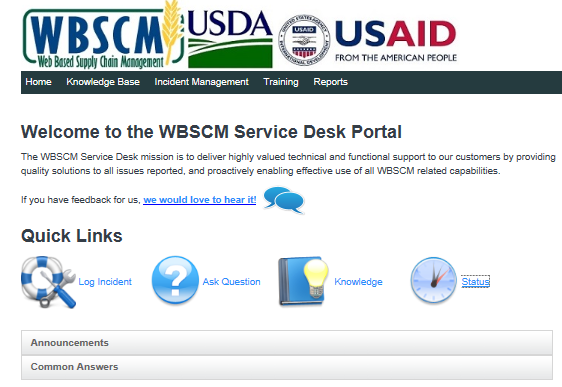
USDA staff will be participating in this upcoming national meeting in 2016. We look forward to the opportunity to meet you and hope to see you there!
October 31 - November 3: 2016 USDA/State Agency Meeting, Arlington,
Virginia. USDA Foods presentations include a pre-conference session, USDA Foods
– Behind the Scenes, and three break-out sessions: Manage USDA & Commercial
Food Chains Like a Pro, USDA Foods: What Child Nutrition Staff Need to Know,
and USDA Resources: Available to Assist When Handling Disasters.
This meeting is intended for State agency representatives
working with Child Nutrition Programs.
|
Here's how to sign up for these updates via GovDelivery:
1. Go to the Food Distribution website.
2. Click on the red envelope on the row of social media icons on the top right of the page.
3. Enter your email address and click "Submit."
4. Check the boxes to select your topics of interest. For these e-letters, scroll down to the Food Distribution category and click the plus sign to the left of the check box to expand the list and view all the sub-categories. Check these sub-categories to receive the corresponding e-letters:
|
*USDA Foods --> receive all "USDA Foods from Farm to Plate" general + program-specific e-letters
*Commodity Supplemental Food Program (CSFP) --> receive "Household Highlights" e-letter
*The Emergency Food Assistance Program (TEFAP) --> receive "Household Highlights" e-letter
*Food Distribution Program on Indian Reservations (FDPIR) --> receive "FDPIR Connection" e-letter
*Schools/Child Nutrition Commodity Programs --> receive "Spotlight on Schools" e-letter
5. Update your subscription preferences any time by following the above steps or clicking on the Subscriber Preferences Page link at the bottom of any of the e-letter email messages you receive from GovDelivery. Questions? Contact us at USDAFoods@fns.usda.gov
|